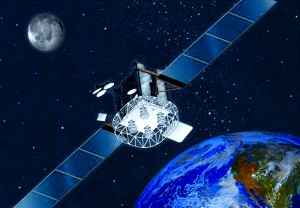Spacecraft, Ground Equipment Triad Ensures Combat Connectivity
 |
The U.S. Navy's Mobile User Objective System (MUOS) is scheduled to enter service in 2009. MUOS consists of a space segment, groundstations and mobile user terminals. The satellites will provide unprotected, narrowband ultrahigh frequency communications capable of reaching handheld devices under adverse signal and weather conditions. |
At the end of this decade, warfighters will begin using an advanced satellite system to maintain on-the-move connectivity with small handheld and vehicle-mounted radios. The planned constellation will provide U.S. military and civilian government agencies with a mobile communications capability that currently is not available. New waveforms and algorithms will permit cellular telephone-size devices to receive signals through dense jungle canopies and bad weather.
Connectivity is vital for troops in battle because it maintains situational awareness and forms a critical command and control link between unit and theater commanders. But recent experiences in Iraq demonstrated that, in spite of advances since the first Gulf War, atmospherics and bandwidth issues continue to trouble U.S. forces.
The Mobile User Objective System (MUOS) is being developed to meet the services’ current and future satellite communications needs. Administered by the U.S. Navy’s Space and Naval Warfare Systems Command (SPAWAR), San Diego, the program will deploy a constellation of spacecraft that will provide narrowband ultrahigh frequency (UHF) communications to mobile and fixed-site users worldwide. The system also features a ground infrastructure to manage the network and interface with other communications systems such as the Global Information Grid.
The new network will replace the Ultra High Frequency Follow-On (UFO) satellite communications system, explains Robert Tarleton, MUOS program manager, SPAWAR. UFO became fully operational in the mid-1990s and consists of a constellation of eight spacecraft in geosynchronous orbit. The system was influenced by lessons learned during the first Gulf War because while U.S. forces had satellite communications systems during that conflict, they did not have optimal channel capacity, he says.
But as the UFO satellites age, a new generation of spacecraft must replace them. Another factor favoring a new system is the exponential demand for satellite communications services. U.S. Defense Department studies indicate that the UFO system is oversubscribed by 250 percent. “For every five users that would like to have a UFO channel, two of them get it. There just aren’t enough,” Tarleton explains.
Although MUOS operates at 64 kilobits per second and below, it is vital to disadvantaged users—troops with small handheld radios in cover or broken terrain—because its UHF transmissions can penetrate foliage and weather conditions such as heavy rain. “It’s what the guy at the pointy end of the spear relies on—UHF satellite communications. We want to provide as much as we can with MUOS. It will be a big improvement over UFO, which certainly has done its job, but we’re taking advantage of the [new] technology to provide that increased capability,” he says.
A handheld on-the-move communications capability is a key part of the system. UFO-compatible equipment consists of manportable backpack or vehicle-mounted radios that require users to stop and either set up or direct an antenna toward a satellite. Although a specialized MUOS terminal has not been developed, Tarleton predicts that some versions may be the size of cellular telephones. “The big advantage is more capacity and link availability. You are guaranteed to get the signal to those disadvantaged terminals a higher percentage of the time,” he says.
MUOS also includes a network operations feature consisting of an adaptable, priority-based resource management capability that can respond to changing operational communications needs. The system will interface with Defense Department teleports to access defense information system network services. Satellite telemetry, tracking and command functions will be operated by the Navy’s Integrated Satellite Control System.
As UFO transitions to MUOS, the system must remain backward-compatible to maintain a mix of new and legacy user terminals. Tarleton expects to support nearly 18,000 legacy terminals currently in service. The new equipment will require on-demand services such as narrowband voice, facsimile, low-speed data, alphanumeric short message paging, voice mail and call waiting. But these devices must comply with the Joint Tactical Radio System (JTRS), a family of advanced programmable radios that will range from handheld systems to platform-mounted terminals and fixed sites.
MUOS will feature a new waveform that is JTRS compatible and software compliant architecture (SCA) certified. Tarleton explains that the two teams competing for the MUOS contract, led by Lockheed Martin and the Raytheon Company, must deliver an SCA-compliant waveform that can be ported to any JTRS terminal. “What will make our system better is the fact that we’ll have these software programmable radios that are more capable than what’s out there right now and what’s been out there for years,” he says.
The program originated from a 1996 study to identify new mobile user systems to replace UFO. The first MUOS satellite is scheduled for launch in 2009 with full operational capability achieved by 2013. Navy plans call for the entire system to be completed by 2018. Tarleton adds that the final number of satellites in the constellation varies between the two competing teams. The minimum number required for global coverage is four spacecraft.
A final contract award for MUOS will be issued early in the first quarter of 2004. Both Lockheed Martin and Raytheon claim to have unique solutions, but the firms indicate that they cannot provide much detail because of the current stage of the program.
According to Director of Business Development Frank R. Prautzsch, Raytheon Integrated Communications Systems, Marlborough, Massachusetts, military satellite communications systems must meet three major requirements: bandwidth capacity, protection from jamming and mobility. “You can’t fight wars without mobility,” he explains.
MUOS is a key enabler for a number of other technologies under development, such as embedded systems on precision weapons, unmanned aerial vehicles and soldiers. Prautzsch notes that substantial reductions in size, weight and power must be made to enhance mobility and that these devices must operate easily in communications nets and networks. He describes nets as small, enclosed systems able to interface with external groups, while networks permit operators to work with many other users who can participate in an open, ad hoc manner.
In addition to mobile user terminals, Raytheon’s MUOS solution includes spacecraft, groundstations and management capabilities. Part of this offering involves improved capabilities for maintaining communications between groundstations, spacecraft and mobile user terminals.
The Lockheed Martin team also offers an integrated solution. Leonard F. Kwiatkowski, vice president for military space programs, Lockheed Martin Space Systems Company, Sunnyvale, California, notes that a mobile, over-the-horizon communications capability is the central goal of MUOS. Because modern battlefields are very fluid, traditional ground relays and frequency allocation schemes cannot keep up with rapidly moving forces. “This particular program is focused on exactly those attributes—having small handheld devices able to communicate in a protected manner and to provide sufficient capacities on the battlefield for all user communities to easily network together,” he says.
Lockheed Martin’s offering applies a legacy technology from a previous program where the company built a satellite communications system that operates similar to a cellular telephone network. “We are leveraging the experience from that platform for the ground side [of MUOS], the management of the communications functions as well as the integration into wider global networks,” Kwiatkowski says.
Unlike UFO’s channel-based frequency assignments, MUOS will use a method providing more assured communications without interference. The new capability will have a lower probability for interception and jamming and will simultaneously support more users than UFO. “It’s just a better quality of service, better quality of communications, higher or improved assured reliability and availability of the signal, and a greater [channel] capacity that will be supported at any one point in time,” he explains.
Lockheed Martin’s handheld device does not require a large antenna for on-the-move communications. Kwiatkowski adds that, besides featuring assured interference-free communications for the handsets, the technology provides antijamming capabilities for both uplinks and downlinks.
The company also is automating many of the management functions for satellites and groundstations to increase reliability. “Users shouldn’t have to worry about the spacecraft. They should just pick up the device and be able to talk or send a message, get maps, imagery or intelligence—whatever they need without having to worry about where it’s coming from,” Kwiatkowski says.




Comments